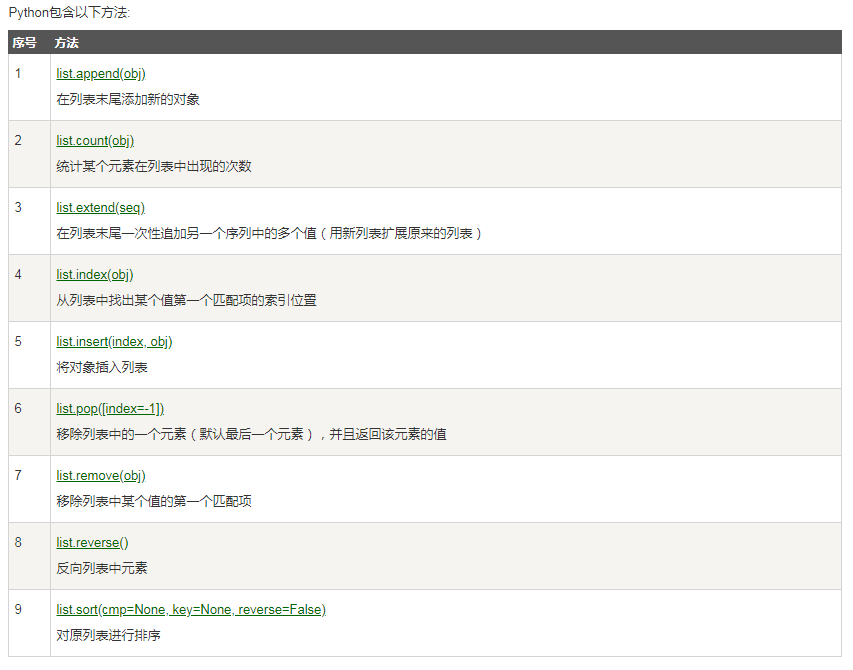元组和列表中的数据是通过偏移量提取,字典中的数据是用字典的键提取的。
元组:只支持查询元素,不支持增加、修改和删除元素。
tuple1 = ('A','B') #从元组中提取元素 print(tuple1[0]) print(tuple1[:]) #输出: A ('A', 'B')
1 tup1 = (12, 34.56) 2 tup2 = ('abc', 'xyz') 3 4 # 创建一个新的元组 5 tup3 = tup1 + tup2 6 print (tup3) 7 #输出:(12, 34.56, 'abc', 'xyz') 8 9 #删除元组 10 tup = ('physics', 'chemistry', 1997, 2000) 11 print (tup) 12 #输出:('physics', 'chemistry', 1997, 2000) 13 14 del tup 15 print (tup) 16 #输出: 17 Traceback (most recent call last): 18 File "d:/py case/1.py", line 14, in <module> 19 print (tup) 20 NameError: name 'tup' is not defined
tuple()方法
语法:tuple( seq ),参数:seq -- 要转换为元组的序列,返回值:元组。
1 #tuple()方法:将序列转换为元组,tuple() 函数不是改变值的类型,而是返回改变类型后的值,原值不会被改变 2 #将列表转换为元组 3 a=[1,2,3,4] 4 a1=tuple(a) 5 print(a) 6 print(a1) 7 8 #针对字典 会返回字典的key组成的tuple 9 b={1:2,3:4} 10 b1=tuple(b) 11 print(b) 12 print(b1) 13 14 #元组会返回元组自身 15 c=(1,2,3,4) 16 c1=tuple(c) 17 print(c) 18 print(c1) 19 20 输出: 21 [1, 2, 3, 4] 22 (1, 2, 3, 4) 23 {1: 2, 3: 4} 24 (1, 3) 25 (1, 2, 3, 4) 26 (1, 2, 3, 4)
列表:用偏移量定位元素,偏移量从0开始,列表切片规则:左取右不取
append每次只能追加一个元素。del语句非常方便,既能删除一个元素,也能一次删除多个元素(原理和切片类似,左取右不取)
1 a=[1,2,4,5,7,'abc'] 2 3 #从列表提取单个元素 4 print(a[0]) 5 输出:1 6 7 #从列表提取多个元素 8 print(a[:2]) 9 输出:[1, 2] 10 11 print(a[1:4]) 12 输出:[2, 4, 5] 13 14 #给列表增加元素 15 a.append(8) 16 print(a) 17 输出:[1, 2, 4, 5, 7, 'abc', 8] 18 19 #给列表删除元素 20 del a[:] 21 print(a) 22 输出:[]

具体用法查看链接:https://www.runoob.com/python/python-lists.html
len()函数:得出一个元组、列表或者字典的长度(元素个数),括号里放元组、列表或字典名称
1 students = ['小明','小红','小刚'] 2 scores = {'小明':95,'小红':90,'小刚':90} 3 print(len(students)) 4 #输出:3 5 print(len(scores)) 6 #输出:3
字典:由键值对组成,字典中的键具备唯一性,而值可重复。
scores = {'小明':95,'小红':90,'小刚':90}
#从字典中提取元素
print(scores['小明'])
#输出:95
#给字典增加/删除元素
scores['小青']=95
print(scores)
#输出:{'小明': 95, '小红': 90, '小刚': 90, '小青': 95}
del scores['小明']
print(scores)
#输出:{'小红': 90, '小刚': 90, '小青': 95}
字典内置函数&方法查看:https://www.runoob.com/python/python-dictionary.html
